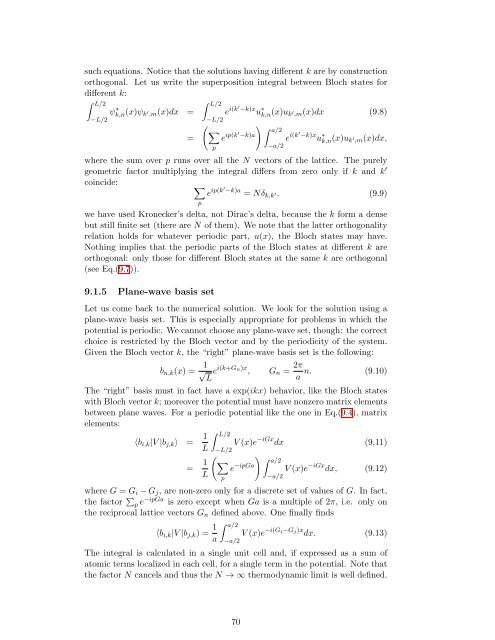Numerical Methods in Quantum Mechanics - Dipartimento di Fisica
Numerical Methods in Quantum Mechanics - Dipartimento di Fisica
Numerical Methods in Quantum Mechanics - Dipartimento di Fisica
You also want an ePaper? Increase the reach of your titles
YUMPU automatically turns print PDFs into web optimized ePapers that Google loves.
such equations. Notice that the solutions hav<strong>in</strong>g <strong>di</strong>fferent k are by construction<br />
orthogonal. Let us write the superposition <strong>in</strong>tegral between Bloch states for<br />
<strong>di</strong>fferent k:<br />
∫ L/2<br />
∫ L/2<br />
ψk,n(x)ψ ∗ k ′ ,m(x)dx = e i(k′ −k)x u ∗ k,n(x)u k ′ ,m(x)dx (9.8)<br />
−L/2<br />
−L/2<br />
( ) ∑ ∫ a/2<br />
= e ip(k′ −k)a<br />
e i(k′ −k)x u ∗ k,n(x)u k ′ ,m(x)dx,<br />
p<br />
−a/2<br />
where the sum over p runs over all the N vectors of the lattice. The purely<br />
geometric factor multiply<strong>in</strong>g the <strong>in</strong>tegral <strong>di</strong>ffers from zero only if k and k ′<br />
co<strong>in</strong>cide:<br />
∑<br />
e ip(k′ −k)a = Nδ k,k ′. (9.9)<br />
p<br />
we have used Kronecker’s delta, not Dirac’s delta, because the k form a dense<br />
but still f<strong>in</strong>ite set (there are N of them). We note that the latter orthogonality<br />
relation holds for whatever perio<strong>di</strong>c part, u(x), the Bloch states may have.<br />
Noth<strong>in</strong>g implies that the perio<strong>di</strong>c parts of the Bloch states at <strong>di</strong>fferent k are<br />
orthogonal: only those for <strong>di</strong>fferent Bloch states at the same k are orthogonal<br />
(see Eq.(9.7)).<br />
9.1.5 Plane-wave basis set<br />
Let us come back to the numerical solution. We look for the solution us<strong>in</strong>g a<br />
plane-wave basis set. This is especially appropriate for problems <strong>in</strong> which the<br />
potential is perio<strong>di</strong>c. We cannot choose any plane-wave set, though: the correct<br />
choice is restricted by the Bloch vector and by the perio<strong>di</strong>city of the system.<br />
Given the Bloch vector k, the “right” plane-wave basis set is the follow<strong>in</strong>g:<br />
b n,k (x) = √ 1 e i(k+Gn)x , G n = 2π n. (9.10)<br />
L a<br />
The “right” basis must <strong>in</strong> fact have a exp(ikx) behavior, like the Bloch states<br />
with Bloch vector k; moreover the potential must have nonzero matrix elements<br />
between plane waves. For a perio<strong>di</strong>c potential like the one <strong>in</strong> Eq.(9.4), matrix<br />
elements:<br />
∫ L/2<br />
〈b i,k |V |b j,k 〉 = 1 L<br />
= 1 ( ∑<br />
L<br />
p<br />
−L/2<br />
V (x)e −iGx dx (9.11)<br />
) ∫ a/2<br />
e −ipGa V (x)e −iGx dx, (9.12)<br />
−a/2<br />
where G = G i − G j , are non-zero only for a <strong>di</strong>screte set of values of G. In fact,<br />
the factor ∑ p e−ipGa is zero except when Ga is a multiple of 2π, i.e. only on<br />
the reciprocal lattice vectors G n def<strong>in</strong>ed above. One f<strong>in</strong>ally f<strong>in</strong>ds<br />
〈b i,k |V |b j,k ) = 1 a<br />
∫ a/2<br />
−a/2<br />
V (x)e −i(G i−G j )x dx. (9.13)<br />
The <strong>in</strong>tegral is calculated <strong>in</strong> a s<strong>in</strong>gle unit cell and, if expressed as a sum of<br />
atomic terms localized <strong>in</strong> each cell, for a s<strong>in</strong>gle term <strong>in</strong> the potential. Note that<br />
the factor N cancels and thus the N → ∞ thermodynamic limit is well def<strong>in</strong>ed.<br />
70
















